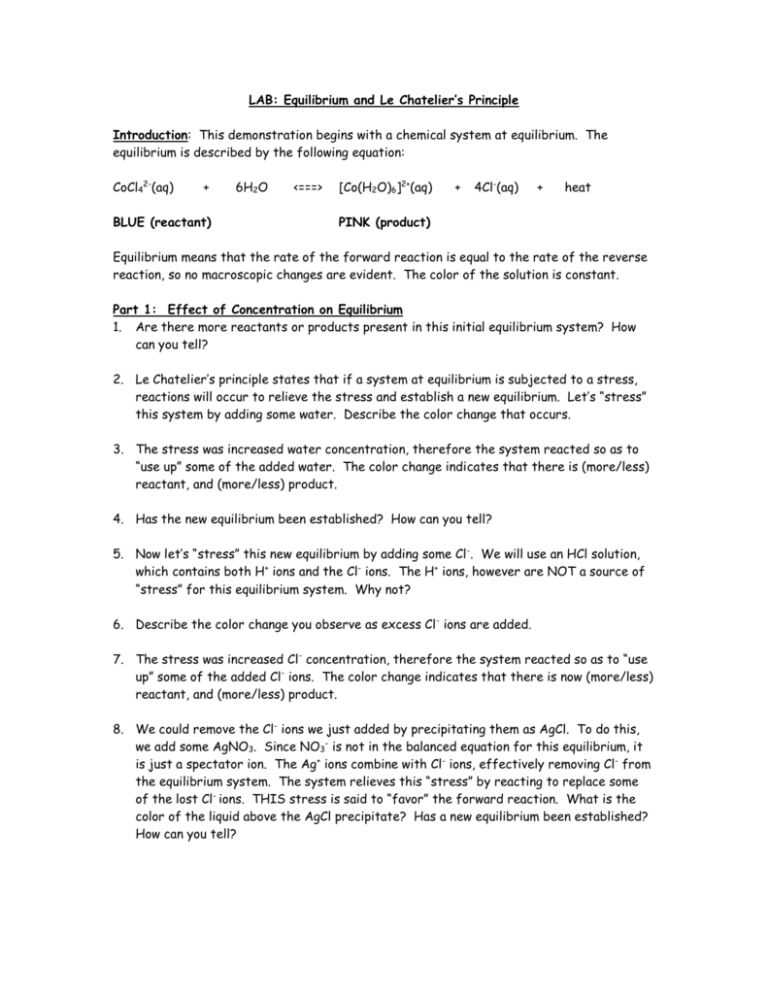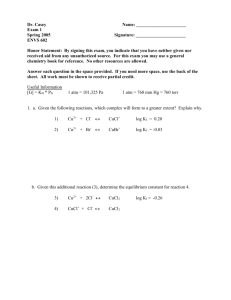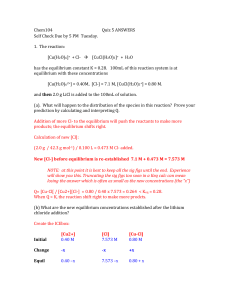Lab 15: Equilibrium and Le Chatelier`s Principle
advertisement

LAB: Equilibrium and Le Chatelier’s Principle Introduction: This demonstration begins with a chemical system at equilibrium. The equilibrium is described by the following equation: CoCl42-(aq) + BLUE (reactant) 6H2O <===> [Co(H2O)6]2+(aq) + 4Cl-(aq) + heat PINK (product) Equilibrium means that the rate of the forward reaction is equal to the rate of the reverse reaction, so no macroscopic changes are evident. The color of the solution is constant. Part 1: Effect of Concentration on Equilibrium 1. Are there more reactants or products present in this initial equilibrium system? How can you tell? 2. Le Chatelier’s principle states that if a system at equilibrium is subjected to a stress, reactions will occur to relieve the stress and establish a new equilibrium. Let’s “stress” this system by adding some water. Describe the color change that occurs. 3. The stress was increased water concentration, therefore the system reacted so as to “use up” some of the added water. The color change indicates that there is (more/less) reactant, and (more/less) product. 4. Has the new equilibrium been established? How can you tell? 5. Now let’s “stress” this new equilibrium by adding some Cl-. We will use an HCl solution, which contains both H+ ions and the Cl- ions. The H+ ions, however are NOT a source of “stress” for this equilibrium system. Why not? 6. Describe the color change you observe as excess Cl - ions are added. 7. The stress was increased Cl- concentration, therefore the system reacted so as to “use up” some of the added Cl- ions. The color change indicates that there is now (more/less) reactant, and (more/less) product. 8. We could remove the Cl- ions we just added by precipitating them as AgCl. To do this, we add some AgNO3. Since NO3- is not in the balanced equation for this equilibrium, it is just a spectator ion. The Ag+ ions combine with Cl- ions, effectively removing Cl- from the equilibrium system. The system relieves this “stress” by reacting to replace some of the lost Cl- ions. THIS stress is said to “favor” the forward reaction. What is the color of the liquid above the AgCl precipitate? Has a new equilibrium been established? How can you tell? Part 2: Effect of Temperature on Equilibrium 1. What color would this equilibrium system be if equal amounts of product and reactants were present? 2. We will set up two test tubes that have equal amounts of product and reactant. One will be placed in hot water and one in cold. Record you observations. a. Color of tube absorbing heat: b. Color of tube releasing heat: 3. In the equation for this equilibrium (as written at the top of this page) endothermic or exothermic? Explain your reasoning. 4. Adding heat stresses this equilibrium system. How does the system relieve this stress? 5. Is a new equilibrium established? How can you tell? 6. Is the temperature effect reversible? How do you know? CoCl42- (aq) + 6H2O <===> BLUE (reactant) [Co(H2O)6]2+(aq) + 4Cl-(aq) + heat PINK (product) So now that you understand Le Chatelier’s Principle, try this: Use and to indicate the change in concentration of each species as a result of the indicated “stress.” Refer to the equation to decide each one. STRESS CoCl4 2- Effect on Concentration of… [Co(H2O)6]2+ Cl- More H2O is added More Cl- is added Some Cl- is removed Heat is added Heat is removed Analysis Question: Paper, soaked in an anhydrous alcohol solution of cobalt chloride, is used to detect the presence of water vapor in the air. What color would this paper be in a dry environment? In a moist environment?








